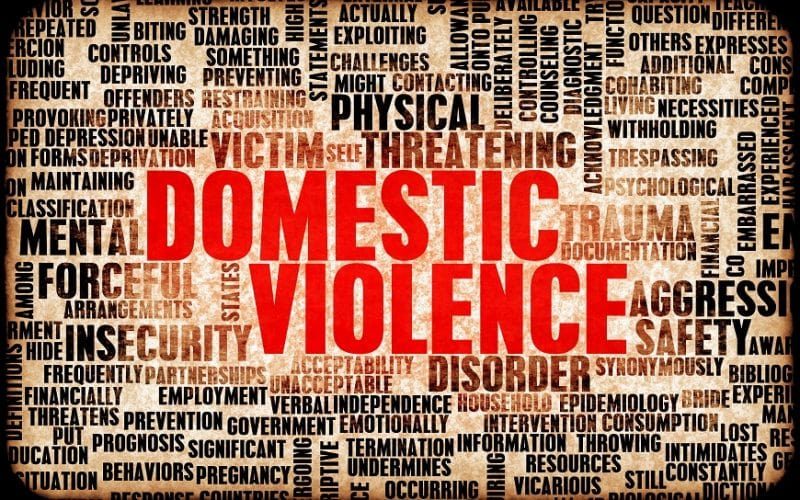Written by : Prarthona Saha
Photo credit : shutterstock.com
1.3 billion people in India were restricted to their homes due to the COVID-19 outbreak. Imposing lockdown might protect us from the coronavirus but this move has intensified a more virulent strain of illness we witness in our society, the disease of domestic violence. Domestic Violence is a global phenomenon. Like the ongoing COVID- 19 pandemic, no country is immune to it. Lockdowns are still being imposed on and off which is only escalating this complex issue. According to the World Health Organization (WHO), globally, one out of three women have faced violence in the form of physical and/or sexual abuse from their partners or sexual violence from non-partners in their lifetime. According to UN Women, 243 million women and girls ages ranging from 15-49 have faced physical and/or sexual violence by an intimate partner during the last twelve months. Less than 40% of women who have experienced violence report such cases. According to the National Crime Records Bureau (NCRB) in 2018 the largest number of crimes committed against women was domestic violence. Majority of cases (31.9%) pertaining to crimes against women recorded under the Indian Penal Code (IPC) were listed under ‘Cruelty by Husband or His Relatives’. This is not only a vicious attack on the human rights of the survivors but this also poses a huge physical and psychological threat to them.
The definition of domestic violence in India encompasses violence inflicted not only by partner or husband but by in-laws, and other members of the family in a domestic setting. The forms of abuse can be physical, psychological, sexual, economic, verbal and also reproductive. It can be overt or covert in nature. Slapping, punching, choking, stabbing etc. are examples of bodily harm while emotional abuse constitutes incessant criticism, verbal attacks, gaslighting and humiliation, which slowly erodes the self-esteem of the survivor. The latter also includes threats, intimidation and emotional blackmail. Rape, unwanted touching or forcing one to not use contraception also constitutes as abuse. Marital rape, although not recognized in India, is also a form of violence the survivors face.Controlling the finances of the survivor, not allowing them to pursue education or have a regular occupation is financial abuse. Other forms of human rights abuse like acid attack, honour killings and cybercrimes are also on the rise.The effect of violence is not just physical but is psychological too. Survivors of domestic violence can experience Post Traumatic Stress Disorder (PTSD), depression, anxiety, substance abuse along with chronic illnesses, sexual illnesses etc.
In cases of domestic violence a cycle of abuse tends to form, which is initiated with a period of acute stress followed by committing an act of violence, which acts as a release for this accumulated stress. This is then followed by a honeymoon or reconciliation phase where the perpetrator usually acts out of guilt or fear. The victim feels pain, humiliation, confusion as the abusers tend to shower them with love. This is then followed by a situation of calm, but then another stressful situation is bound to occur which triggers the cycle again.
With the advent of the pandemic, stress has begun to rise exponentially. Imposing lockdown has led to confinement, isolation and limited mobility. This has created a perfect storm pertaining to the issue of domestic violence. In such a state of immobility, the survivors of domestic violence are the worst affected. Access to help, alternate accommodation and their support system has been abruptly discontinued. Escaping an abusive household has become more unviable during the lockdown. With the escape routes and their support system shrinking, they are suffocating helplessly in their own homes.
The pandemic has created massive volatility in the society as well as the economy as a whole. This has given rise to financial instability, unemployment, and rising concerns relating to health. This coupled with isolation is directly impacting women and girls and creating a huge strain on them. Our societal structures are based on patriarchal ideals which allows misogyny to breed in the relationships we share with our male counterparts. The power dynamics in a relationship is imbalanced where the man usually holds the power, and a woman is taught not to question, is an accepted norm. Children are raised in such a culture where their conditioning is set in these ways, which are repeated generations after generations.
In April, the National Commission for Women (NCW) set up a WhatsApp (a chat application) helpline number +917217735372 for domestic violence survivors who couldn’t ask for help through post or emails. Out of the 1477 complaints received 727 were received via WhatsApp. According to an article in The Hindu, the 1477 complaints pertaining to domestic violence were made between the 25th of March and 31st of May in 2020. The number of grievances recorded in this 68 day period time frame was at an all-time high when compared to the complaints recorded between March and May in the last decade.
Some major findings of the National Family Health Survey (NFHS-4) of 2015-2016 stated that that since the age of 15, 30% of women in India have faced physical violence while 6% faced sexual abuse. A staggering 33% of women have faced violence from their spouse in the form of physical, emotional and sexual abuse. The data also puts forth that only 14% of women who faced abuse came forward to seek help. Reasons for this low number of reporting can be attributed to many causes. Customs and traditions deeply rooted in patriarchy, such as a preference for male children which not only endangers the reproductive rights of a women but can also lead to forced abortions, female foeticide or infanticide. This can also lead to a girl child being neglected and abused. Prevalence of the caste system exacerbates the existing societal norms for the ones placed on the “lower rungs”. Fear and shame of how society will react to their afflictions coupled with victim blaming makes them stay in abusive relationships. Lack of support systems, no safe places to go, economic dependence, lack of accessto resources for help, losing the custody of children, fear of more violence or losing their lives are reasons for not leaving an abusive relationship. Many women have also internalized patriarchal ideals where they believe abuse in “normal”, while some believe that their partners might change their behavior as time passes. Low self-esteem entices the survivors into this vicious cycle. Even when women reach out for help, they are asked to “adjust” as the badge of honour rests with women and girls in a society like ours. They must not bring shame to their families by leaving their husbands, or doing anything that is socially frowned upon. This is a huge blow to their confidence and churns out every bit of hope out from their lives.
There are several laws and policies in place to safeguard women especially the landmark, Protection of Women from Domestic Violence Act, 2005. This legislation makes provisions for protection of the survivors, monetary relief, residence orders, compensation orders and also custody orders. However, there is a lack of a cohesive approach towards implementation, tiring bureaucratic procedures that wrings an already traumatized survivor, and lack of uniformity in the protocol all over the country. The systemic flaws can be improved upon by prioritizing gender based discrimination and violence.There are a few solutions that can be worked on during the ongoing pandemic. Services that deal with violence against women should be deemed as essential services. Ensuring enough availability and access to emergency shelters should be ensured for their rehabilitation. Spaces like stadiums, hotels etc. have been repurposed during the pandemic as quarantine centres, the same can be converted to shelter the domestic violence survivors. Strengthening and ensuring counselling and other forms of psychosocial support by using technology and by involving various social media platforms, can be made available to them. Popularizing helpline numbers can raise awareness and provide assurance to the survivors that there are avenues to access help. Civil society organizations can also play a huge role in advocacy and sensitizing the masses through media and direct engagement through technology. Sensitization and capacity building of the stakeholders like the judiciary, police, and the healthcare professionals can be done virtually to raise awareness about dealing with such cases more delicately and proactively.
World view:
According to a statement made by Phumzile Mlambo-Ngcuka, Executive Director of UN Women, Governmental and non-governmental bodies in the United States, United Kingdom, Spain, Canada, Argentina and Germany have also identified a spike in the reporting of cases of domestic violence coupled with a growing demand for shelters. According to UN Women France has reported a 30% increase in domestic violence since the imposition of the lockdown, emergency calls in Argentina witnessed a 25% increase and Cyprus witnessed an upsurge in helpline numbers by 30%. An upward shift of increased violence has been observed in conflict areas and emergencies. Similar trends were observed during the Zika and Ebola pandemic. Data emerging from various countries are reflecting a similar trajectory for the current COVID-19 pandemic too. Unique measures have been taken by various countries to curb domestic violence. France accommodated the survivors in hotels as their shelters were running at capacity. It has also very recently adopted a bill which permits health professionals to break confidentiality in cases of imminent danger. This bill also increases the sentence of the abuser who abetted or led to the suicide of the victim. Canada announced a $50 million aid package to support survivors of domestic violence. In certain parts of the country, shelters were declared as essential services. United Kingdom, Australia and other countries have allocated funds to organizations supporting survivors. In Antigua and Barbuda many mobile service providers are allowing free calls to helplines. In the Canary Islands, Spain, women use the code word “Mask 19” in pharmacies for assistance pertaining to a situation of domestic violence. Many countries are allowing online hearing of proceedings to avoid backlog and maintain a functioning judicial system. Some online platforms are providing resources and help during these trying times.
From an individual point of view, we can all proactively recognize, unlearn and challenge gender stereotypes and educate ourselves on gender based discriminations. We can try to be more aware of our legal rights and duties, so that we are equipped to deal with such instances. Increasing visibility of violence against women can help in raising more awareness and doing away with the stigma attached to it. A recurring support system, proper implementation of the existing laws as well as stricter laws can curb this emergent situation. Donating to local women rights organizations can also aid in bridging the gap between the services available and required.
Home invokes a sense of security and calm, however, for many women it has become a place of nightmare. With the advent of our ‘new normal’ things have changed drastically overnight. The pandemic has turned our world upside down. The imposition of lockdown has been a common remedy to slow down the spread of the virus globally. This step is keeping millions safe from the virus but it is placing women and children in grave danger of domestic violence. The COVID-19 pandemic might even end with a vaccine shot but the other pandemic has to be uprooted from its core, which would need proactive societal participation and prioritizing the safety and well-being of the survivors. Women’s safety and well-being should not be the collateral damage our society is willing to sacrifice to curb the virus. Let us make home a safe place for them again.
Prarthona Saha
The author has a Masters degree in Human Rights and is currently employed in the private sector
From Kolkata, India.




